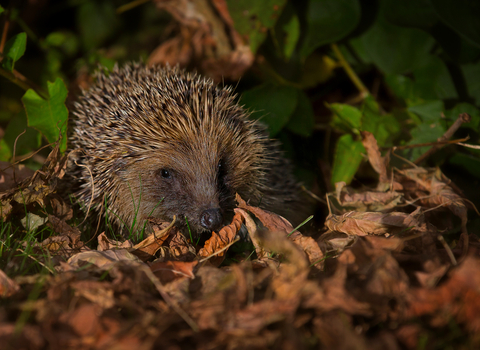
Hedgehog © Jon Hawkins - Surrey Hills Photography
European hedgehog
Scientific name
Erinaceus europaeusWhen to see
April to OctoberSpecies information
Category
Statistics
Length: 15-30cmTail: 1-2cm
Weight: up to 2kg
Average lifespan: 2-3 years
IUCN Red List for British Mammals - vulnerable to extinction.
About
Round, brown and famously covered in spines, the hedgehog is the UK’s most familiar wild animal. They can be spotted in parks and gardens where bushes provide the perfect daytime getaway! They love long grass full of insects to feast on once the sun has set.Hedgehogs eat all kinds of invertebrates, as well as amphibians, birds' eggs and anything else they can catch; they particularly like big, crunchy beetles and earthworms, making them a gardener's best friend. Hedgehogs hibernate over winter, from about November to April, in a nest of leaves or logs called a 'hibernaculum'.
How to identify
A unique and unmistakeable animal, the hedgehog is small, brown and round, with yellow-tipped spines over its back, and a fur-covered face. Mostly nocturnal, you may see or hear one snuffling around the garden. Or look out for the signs of hedgehogs, such as medium-sized, black droppings full of insect bits on the lawn.Distribution
Widespread, found throughout the country in a variety of habitats, though absent from some Scottish Islands. A large proportion of the hedgehogs on Alderney are blonde!In our area
To reverse the rapid decline, Cornwall Wildlife Trust is leading Operation Hedgehog, a coordinated effort to take hedgehog-saving, county-wide action.
Who is involved?
Operation Hedgehog is being delivered in partnership with Cornwall Mammal Group, Prickles and Paws Hedgehog Rescue and the University of Exeter.
What are the aims?
We will...
- identify the whereabouts and sizes of hedgehog populations through initiatives such as expert and citizen science surveys
- educate and work with land managers, developers and policy makers to protect hedgehogs when planning new developments
- support volunteer community groups to spread the word and build homes for hedgehogs
How can you help?
To coordinate hedgehog-saving action across the county and ensure these activities are effective, we need your help. Right now, the best action you can take is to donate to our Hedgehog Appeal. It takes less than two minutes and will enable us to begin taking the steps required to reverse this decline. Your contribution to the £25,000 target will make a difference.
Did you know?
Hedgehogs are known for their ability to roll themselves into a ball of spines when threatened. These spines are actually modified hairs and the average hedgehog has about 7000 of them, which can be raised using powerful muscles along their back.Watch
Hedgehog (https://vimeo.com/473378502)
Hedgehog by Stuart Edmunds
To reverse the rapid decline, Cornwall Wildlife Trust is leading Operation Hedgehog, a coordinated effort to take hedgehog-saving, county-wide action.
Who is involved?
Operation Hedgehog is being delivered in partnership with Cornwall Mammal Group, Prickles and Paws Hedgehog Rescue and the University of Exeter.
What are the aims?
We will...
- identify the whereabouts and sizes of hedgehog populations through initiatives such as expert and citizen science surveys
- educate and work with land managers, developers and policy makers to protect hedgehogs when planning new developments
- support volunteer community groups to spread the word and build homes for hedgehogs
How can you help?
To coordinate hedgehog-saving action across the county and ensure these activities are effective, we need your help. Right now, the best action you can take is to donate to our Hedgehog Appeal. It takes less than two minutes and will enable us to begin taking the steps required to reverse this decline. Your contribution to the £25,000 target will make a difference.
